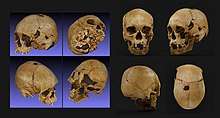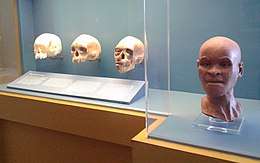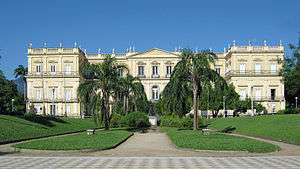Luzia Woman
 Remains as displayed at the National Museum of Brazil in Rio de Janeiro | |
| Catalog no. | Lapa Vermelha IV Hominid 1 |
|---|---|
| Common name | Luzia |
| Species | Paleo-Indian |
| Age | 11,243–11,710 cal BP |
| Place discovered | Belo Horizonte, Brazil |
| Date discovered | 1974 |
| Discovered by | Annette Laming-Emperaire |
Luzia Woman (Portuguese pronunciation: [luˈzi.ɐ]) was the name for an Upper Paleolithic period skeleton of a Paleo-Indian woman who was found in a cave in Brazil. Some archaeologists believed the young woman may have been part of the first wave of immigrants to South America. The 11,500-year-old skeleton was found in a grotto in Lapa Vermelha, Pedro Leopoldo, Great Belo Horizonte, Brazil, in 1974 by archaeologist Annette Laming-Emperaire.[1][2]
The fossil was kept at the National Museum of Brazil, where it was shown to the public. It is not known whether it survived the fire that destroyed the museum on September 2, 2018, but there is a strong possibility the remains were lost.[3][4] The nickname Luzia pays homage to the Australopithecus fossil "Lucy".[5]
History

Luzia was originally discovered in 1974 in a rock shelter by a joint French-Brazilian expedition that was working not far from Belo Horizonte, Brazil. The remains were not articulated. The skull, which was separated from the rest of the skeleton but was in surprisingly good condition, was buried under more than forty feet (12 meters) of mineral deposits and debris.
There were no other human remains at the site. New dating of the bones announced in 2013 confirmed that at an age of 10,030 ± 60 14C yr BP (11,243–11,710 cal BP), Luzia is one of the most ancient American human skeletons ever discovered.[6] Forensics have determined that Luzia died in her early 20s. Although flint tools were found nearby, hers were the only human remains found in Vermelha Cave.
The fossil of Luzia is believed to have been destroyed when the National Museum burned according to officials,[7][8][9] but firefighters later discovered a human skull within the burned museum which is being examined to determine if it belonged to Luzia.[10]
Phenotypical analysis


Her facial features included a narrow, oval cranium, projecting face and pronounced chin, strikingly dissimilar to most Native Americans and their indigenous Siberian forebears. Anthropologists variously described Luzia's features as resembling those of Negroids, Indigenous Australians, Melanesians and the Negritos of Southeast Asia. Walter Neves, an anthropologist at the University of São Paulo, suggests that Luzia's features most strongly resembled those of Australian Aboriginal peoples. Richard Neave of Manchester University, who undertook a forensic facial reconstruction of Luzia described it as negroid.[11]
Neves and other Brazilian anthropologists theorized that Luzia's Paleo-Indian predecessors lived in South East Asia for tens of thousands of years, after migrating from Africa, and began arriving in the New World, as early as 15,000 years ago. The oldest confirmed date for an archaeosite in the Americas is 18,500 and 14,500 cal BP. for the Monte Verde site in southern Chile.[12] Some anthropologists have hypothesized that a population from coastal East Asia migrated in boats along the Kuril island chain, the Beringian coast, and down the west coast of the Americas during the decline of the Last Glacial Maximum.[13][14]
Neves' conclusions have been challenged by research done by anthropologists Rolando González-José, Frank Williams and William Armelagos who have shown in their studies that the cranio-facial variability could just be due to genetic drift and other factors affecting cranio-facial plasticity in Native Americans.[15][16][17]
A comparison in 2005 of Lagoa Santa specimens with modern Aimoré people of the same region also showed strong affinities, leading Neves to classify the Botocudos as Paleo-Indians.[18]
Anthropometry
Luzia stood just under five feet (1.5 m) tall—about one-third of her skeleton has been recovered. Her remains seem to indicate that she died either in an accident or as the result of an animal attack. She was a member of a group of hunter-gatherers.
See also
- Collection of fossils in the National Museum of Brazil
- Genetic history of indigenous peoples of the Americas
- Settlement of the Americas
- Human remains
- Archeological sites
References
- ↑ Smith, C. (18 February 2000). "Luzia Woman". Cabrillo College. Discovery Communications Inc. Retrieved 21 December 2007.
- ↑ "Busca pelo crânio de Luzia continua um mês após incêndio no Museu Nacional" (in Portuguese). em.com.br. Retrieved 4 October 2018.
- ↑ Stargardter, Gabriel (September 4, 2018). "Skull of ancient human possibly found in burned Brazilian museum". Reuters. Retrieved 7 September 2018.
- ↑ Solá-Santiago, Frances (September 24, 2018). "The Story of Luzia, the Oldest Human Skull Found in the Americas". Remezcla. Retrieved 25 September 2018.
- ↑ "O crânio de Luzia, a mais antiga habitante das Américas, pode ter desaparecido no incêndio do Museu Nacional" (in Portuguese). O Globo. Retrieved 8 October 2018.
- ↑ Fontugne, MIchel (2013). "New Radiocarbon Ages of Luzia Woman, Lapa Vermelha IV Site, Lagoa Santa, Minas Gerais, Brazil". Proceedings of the 21st International Radiocarbon Conference. 55 (2–3). doi:10.2458/azu_js_rc.55.16253. Retrieved 27 December 2013.
- ↑ "Brazil's First Human "Luzia" Destroyed In Rio De Janeiro's Museum Fire". NDTV.com. Retrieved 2018-09-04.
- ↑ "Especialista compara perda do fóssil Luzia com destruição da Mona Lisa". R7. Retrieved 2018-09-04.
- ↑ "Brazil Museum Fire Leaves Ashes, Recrimination and Little Else". The New York Times. Retrieved 2018-09-04.
- ↑ Stargardter, Gabriel (September 4, 2018). "Skull of ancient human possibly found in burned Brazilian museum". Reuters. Retrieved 7 September 2018.
- ↑ Larry Rohter (26 Oct 1999). "An Ancient Skull Challenges Long-Held Theories". New York Times. Retrieved 2008-02-15.
- ↑ Dillehay, Tom D.; Ocampo, Carlos (November 18, 2015). "New Archaeological Evidence for an Early Human Presence at Monte Verde, Chile". PLoS ONE. 10 (11): e0141923. doi:10.1371/journal.pone.0141923.
- ↑ Erlandson, Jon M. & Braje, Todd J., From Asia to the Americas by boat? Paleogeography, paleoecology, and stemmed points of the northwest Pacific (PDF)
- ↑ Adachi N.; Shinoda K.; Umetsu K. & Matsumura H. (2009), "Mitochondrial DNA analysis of Jomon skeletons from the Funadomari site, Hokkaido, and its implication for the origins of Native American, Am J Phys Anthropol. 2010 Mar;141(3):504-5", American Journal of Physical Anthropology, 138 (3): 255–65, doi:10.1002/ajpa.20923, PMID 18951391
- ↑ van Vark GN, Kuizenga D, Williams FL (June 2003). "Kennewick and Luzia: lessons from the European Upper Paleolithic". American Journal of Physical Anthropology. 121 (2): 181–4, discussion 185–8. doi:10.1002/ajpa.10176. PMID 12740961.
- ↑ Fiedel, Stuart J. (2004). "The Kennewick Follies: 'New' Theories about the Peopling of the Americas". Journal of Anthropological Research. 60 (1): 75–110. JSTOR 3631009.
- ↑ González-José R, Bortolini MC, Santos FR, Bonatto SL (October 2008). "The peopling of America: craniofacial shape variation on a continental scale and its interpretation from an interdisciplinary view". American Journal of Physical Anthropology. 137 (2): 175–87. doi:10.1002/ajpa.20854. PMID 18481303.
- ↑ Lopes, Reinaldo José (10 Oct 2005). "Os sobreviventes: Crânios de índios extintos do Brasil Central indicam elo com primeiros povoadores da América" [Survivors: skulls of extinct Indians of Central Brazil indicate link with the first settlers of America]. Jornal da Ciência (in Portuguese). Retrieved 2008-02-15.
External links

.svg.png)
